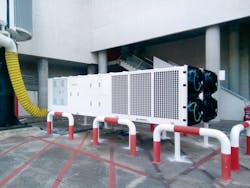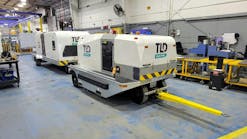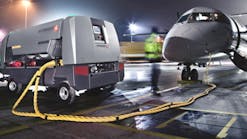Whether prompted by new energy-saving initiatives or simply a desire to protect the earth, people around the world are looking for ways to reduce their impact on the environment. The aviation world is no exception.
According to a press release from Airport Council International (ACI), the Intergovernmental Panel on Climate Change (IPCC) has estimated that aviation’s total CO2 emissions account for 2 percent of global emissions’ impact on climate change.
The figure noted that airports’ own operations only account for up to 5 percent. However, airports are seeking ways to reduce greenhouse gas emissions and become carbon neutral. In fact, multiple airports have already done so.
One way airports can reduce emissions, especially if a station is seeking to be certified in the Airport Carbon Accreditation program, is to seek out environmentally friendly ground support equipment (GSE).
Officials at ADELTE point to energy efficient pre-conditioned air (PCA) units as a logical place to reduce emissions.
“GSE, including PCAs, are one piece of this action that airports can do to reach this level of carbon neutrality,” says François Mamert, marketing director at ADELTE. “More and more airports are reducing the minutes allowed by the use of the APU – the auxiliary power units – of the aircraft.”
When airports limit the amount of time aircraft can utilize APUs, an alternative solution must be offered to keep the planes at a comfortable temperature for passengers. Mamert says a PCA is a win-win for airports and airlines.
“The service of the PCA is a new way for airports to generate income because they’ll charge the airline,” he says, adding airlines are happy to pay for PCA service because it is less expensive than paying for the fuel needed to run the aircraft’s APU.
“Air pollution, CO2, NOx or micro-particles are reduced to almost 0 percent, compared to the use of APUs,” Mamert adds.
ADELTE offers two ranges of PCA equipment – standard PCA units and others equipped with the company’s full inverter technology. The inverter technology offers additional efficiencies, according to Raul Perez, PCA sales manager at ADELTE.
This range of PCAs utilizes two inverter compressors, and a direct drive centrifugal blower managed by a frequency driver in order to use less energy. Perez notes numerous parameters can be adjusted so that the PCA is operating at the appropriate capacity, regardless of the aircraft’s size.
“You can modify the frequency from 20 to 100 hertz along a range of frequencies,” he says. “We can review and select frequency and decrease the load.
“All of this can adapt the capacity.”
“Most PCAs or standard PCAs run off one compressor. They’re functioning 100 percent or they’re not functioning,” Mamert adds, noting a PCA does not necessarily need to run at full power to effectively control the temperature of a cabin.
ADELTE’s PCA inverter is capable of cooling and heating parked aircraft. When heating planes, the unit uses a heat pump that is integrated into the system. The heat pump consumes less electricity than other PCAs that utilize an electrical resistor.
In fact, Perez points out ADELTE’s PCAs equipped with a heat pump are three times more efficient than similar models relying on an electrical resistor.
What’s more, these PCAs use R-410A refrigerant, which provides greater efficiency and significantly reduces refrigerant load and CO2 emissions.
The unit’s PLC control allows the PCAs to be accessed remotely or via a touchscreen interface that allows users to control all function parameters during operations, which helps ensure efficiency, too.
While ADELTE’s inverter technology is still relatively new, it has been installed at a number of airports, including Palma de Mallorca Airport in Spain where multiple units have been operated for a year and a half.
“It’s giving good results,” Mamert says.
ADELTE developed the technology as part of the company’s effort to return to the airport market in 2012. Already offering boarding bridges, company officials determined that those customers seeking passenger boarding solutions would also need PCAs to keep those people comfortable onboard the plane.
“We wanted to be able to offer the full package to our clients,” Perez says.
Additionally, ADELTE sought feedback from those clients about the challenges they faced on the ramp. That response resulted in the creation of the inverter technology.
“Because we have a good relationship in the airports with the maintenance workers, and want to improve our products at the gate, we received the feelings of the people of the airport – the people working with the PCA,” Perez says.
Communicating with customers has been key, not only for developing new technology, but also ensuring the appropriate PCA unit is installed for that particular airport.
“We take a lot of areas into considerations in order to have the client choose the right technology, the right model and the right size of PCA,” Mamert says. “It depends on the location, it depends on the weather, the humidity and the temperature, and on the aircraft code.”
The key is to be efficient, and Mamert explains efficiency can refer to the economic impact for a customer as well as the environmental impact on the planet.
“In the end, it’s a basic concept,” Mamert says. “You’re just giving what is needed. Not more.”





